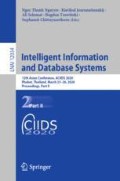Abstract
Cognitive symptoms are characteristic for neurodegenerative disease: there are dominating in the Alzheimer’s, but secondary in Parkinson’s disease (PD). However, in PD motor symptoms (MS) are dominating and their characteristic helps neurologist to recognize the disease. There are a large number of data mining publications that analyzed MS in PD. Present study is related to the question if development of cognitive symptoms is related to motor symptoms or if they are two independent processes? We have responded to this problem with help of IGrC (intelligent granular computing) approach. We have put together eye movement, neurological and neuropsychological tests. Our study was dedicated to 47 Parkinson’s disease patients in two sessions: S#1 - without medications (MedOFF) and S#2 after taking medications (MedON). There were two groups of patients: Gr1 (23 patients) less advanced and Gr2 more advanced PD. We have measured Gr1 in three visits every 6 months: Gr1VIS1, Gr1VIS2, Gr1VIS3. Gr2 (24 patients) has only one visit (no visit number). With rough set theory (RST) that belongs to IGrC we have found from Gr2 three different sets of rules: a) general rules (GRUL) determined by all attributes; b) motor related rules (MRUL) – motor attributes; c) cognitive rules (CRUL) determined by cognitive attributes. By applying these different sets of rules to different Gr1 visits we have found different set of symptoms developments. With GRUL we have found for Gr1VIS1 accuracy = 0.682, for Gr1VIS2 acc. = 0.857, for Gr1VIS3 acc. = 0.875. With MRUL we have found for Gr1VIS1 acc. = 0.80, for Gr1VIS2 acc. = 0.933, for Gr1VIS3 acc. = 1.0. With CRUL we have found for Gr1VIS1 acc. = 0.50, for Gr1VIS2 acc. = 0.60, for Gr1VIS3 acc. = 0.636. Cognitive changes are independent from the motor symptoms development.
Access this chapter
Tax calculation will be finalised at checkout
Purchases are for personal use only
References
Przybyszewski, A.W., Kon, M., Szlufik, S., Szymanski, A., Koziorowski, D.M.: Multimodal learning and intelligent prediction of symptom development in individual Parkinson’s patients. Sensors 16(9), 1498 (2016)
Przybyszewski, A.W.: Fuzzy RST and RST rules can predict effects of different therapies in Parkinson’s disease patients. In: Ceci, M., Japkowicz, N., Liu, J., Papadopoulos, G.A., Raś, Z.W. (eds.) ISMIS 2018. LNCS (LNAI), vol. 11177, pp. 409–416. Springer, Cham (2018). https://doi.org/10.1007/978-3-030-01851-1_39
Pawlak, Z.: Rough Sets: Theoretical Aspects of Reasoning About Data. Springer, Dordrecht (1991). https://doi.org/10.1007/978-94-011-3534-4
Jankowski, A.: Interactive Granular Computations in Networks and Systems Engineering: A Practical Perspective. LNNS, vol. 17. Springer, Cham (2017). https://doi.org/10.1007/978-3-319-57627-5
Bazan, J., Nguyen, S.H., et al.: Desion rules synthesis for object classification. In: Orłowska, E. (ed.) Incomplete Information: Rough Set Analysis, Physica – Verlag, Heidelberg, pp. 23–57 (1998)
Przybyszewski, A.W.: Applying data mining and machine learning algorithms to predict symptom development in Parkinson’s disease. Ann. Acad. Med. Siles. 68(5), 332–349 (2014)
Bazan, J., Nguyen, H.S., Nguyen, S.H., et al.: Rough set algorithms in classification problem. In: Polkowski, L., Tsumoto, S., Lin, T. (eds.) Rough Set Methods and Applications, pp. 49–88. Physica-Verlag, Heidelberg (2000). https://doi.org/10.1007/978-3-7908-1840-6_3
Grzymała-Busse, J.: A New Version of the Rule Induction System LERS. Fundamenta Informaticae 31(1), 27–39 (1997)
Bazan, J.G., Szczuka, M.: The rough set exploration system. In: Peters, J.F., Skowron, A. (eds.) Transactions on Rough Sets III. LNCS, vol. 3400, pp. 37–56. Springer, Heidelberg (2005). https://doi.org/10.1007/11427834_2
Przybyszewski, A.W.: The neurophysiological bases of cognitive computation using rough set theory. In: Peters, J.F., Skowron, A., Rybiński, H. (eds.) Transactions on Rough Sets IX. LNCS, vol. 5390, pp. 287–317. Springer, Heidelberg (2008). https://doi.org/10.1007/978-3-540-89876-4_16
Bazan, J.G., Szczuka, M.: RSES and RSESlib - a collection of tools for rough set computations. In: Ziarko, W., Yao, Y. (eds.) RSCTC 2000. LNCS (LNAI), vol. 2005, pp. 106–113. Springer, Heidelberg (2001). https://doi.org/10.1007/3-540-45554-X_12
Przybyszewski, A.W., Nowacki, J.P., Drabik, A., Szlufik, S., Habela, P., Koziorowski, D.M.: Granular computing (GC) demonstrates interactions between depression and symptoms development in Parkinson’s disease patients. In: Nguyen, N.T., Gaol, F.L., Hong, T.-P., Trawiński, B. (eds.) ACIIDS 2019. LNCS (LNAI), vol. 11432, pp. 591–601. Springer, Cham (2019). https://doi.org/10.1007/978-3-030-14802-7_51
Przybyszewski, A.W.: Parkinson’s Disease Development Prediction by C-Granule Computing. In: Nguyen, N.T., Chbeir, R., Exposito, E., Aniorté, P., Trawiński, B. (eds.) ICCCI 2019. LNCS (LNAI), vol. 11683, pp. 296–306. Springer, Cham (2019). https://doi.org/10.1007/978-3-030-28377-3_24
Khoury, N., Attal, F., Amirat, Y., Oukhellou, L., Mohammed, S.: Data-driven based approach to aid Parkinson’s disease diagnosis. Sensors (Basel) 19(2), 242 (2019). https://doi.org/10.3390/s19020242
Yadav, G., Kumar, Y., Sahoo, G.: Predication of Parkinson’s disease using data mining methods: a comparative analysis of tree, statistical, and support vector machine classifiers. Indian J. Med. Sci. 65(6), 231–242 (2011)
Author information
Authors and Affiliations
Corresponding author
Editor information
Editors and Affiliations
Rights and permissions
Copyright information
© 2020 Springer Nature Switzerland AG
About this paper
Cite this paper
Przybyszewski, A.W., Nowacki, J.P., Drabik, A., Szlufik, S., Koziorowski, D.M. (2020). IGrC: Cognitive and Motor Changes During Symptoms Development in Parkinson’s Disease Patients. In: Nguyen, N., Jearanaitanakij, K., Selamat, A., Trawiński, B., Chittayasothorn, S. (eds) Intelligent Information and Database Systems. ACIIDS 2020. Lecture Notes in Computer Science(), vol 12034. Springer, Cham. https://doi.org/10.1007/978-3-030-42058-1_46
Download citation
DOI: https://doi.org/10.1007/978-3-030-42058-1_46
Published:
Publisher Name: Springer, Cham
Print ISBN: 978-3-030-42057-4
Online ISBN: 978-3-030-42058-1
eBook Packages: Computer ScienceComputer Science (R0)

